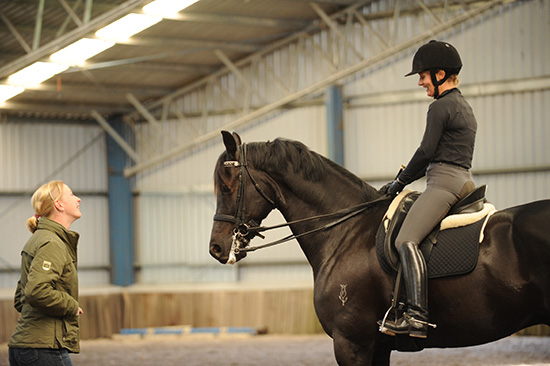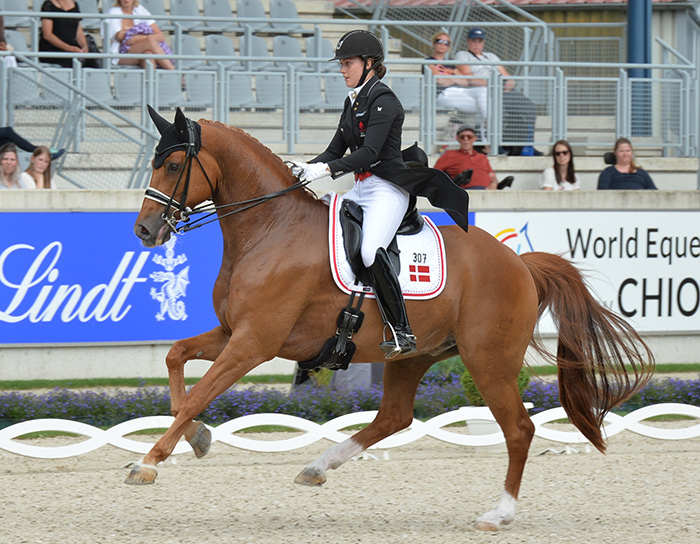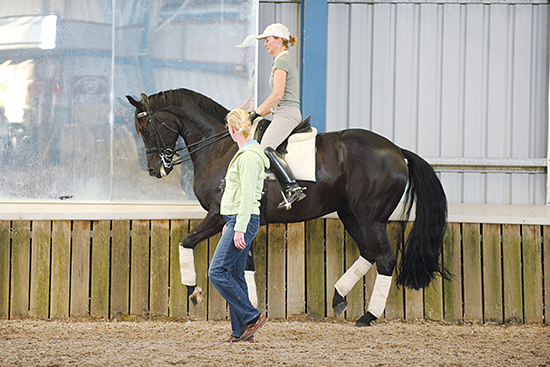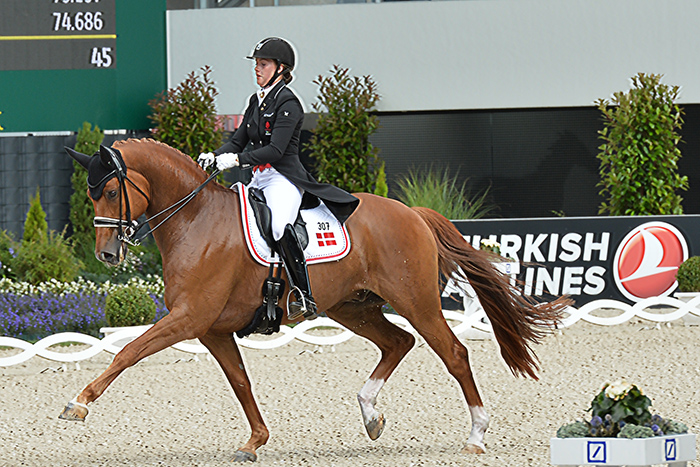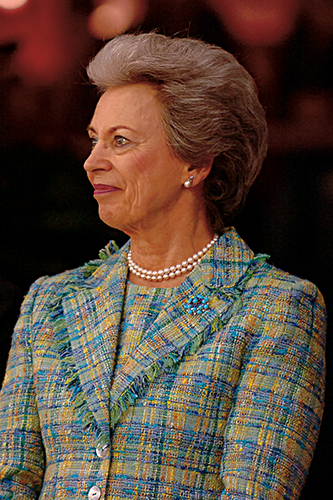Princess Nathalie zu Wittgenstein, has proven herself one of the world’s top dressage competitors, but she is also an exceptional trainer of riders, and that is why she is currently the coach of two of the very top in the world, Cathrine Dufour and Daniel Bachmann. In this article she unravels one of the most confusing concepts in the world of dressage – Throughness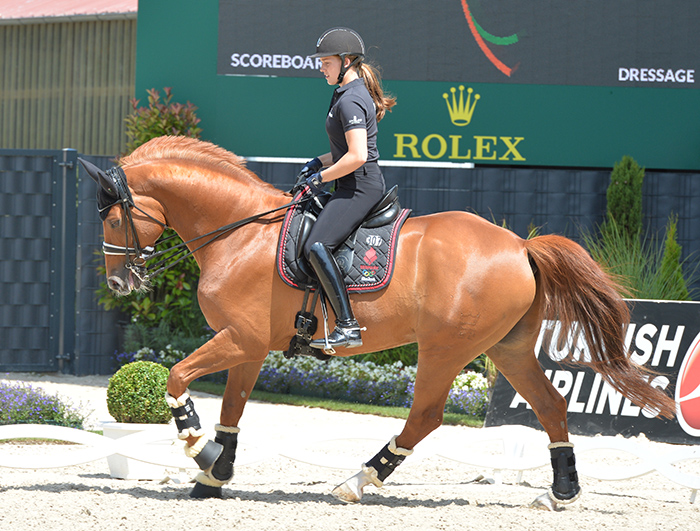
Danish winning team members, and individual medal winners, Cathrine Dufour in the warm up at Aachen
As Christopher Hector discovered, Nathalie believes it is all a matter of balance:
“The left hand balances the left shoulder, the right hand balances the right shoulder, the horse is not allowed to balance himself on your hands, you’re only allowed to have the shoulders on your hands.”
‘Tell him to stay in the middle of his shoulders and to keep your lower leg on the girth, not behind, so as to keep him ‘straight underneath you.”
“If he gets heavy on the outside rein, little half halt with inside rein, but keep him straight, and then halt. He has to wait for you. Keep both shoulders in your hands, making a tunnel through your hands, and you want to keep his shoulders in that tunnel.”
Cathrine and Cassidy demonstrate
“Put his hind legs under your seat. Once he stays there you can ride him bigger.”
“The horse needs to have his weight on his hindquarters so that you can move his shoulders anywhere you want to, if his weight is on his shoulders you cannot move them.”
“Let him go slightly longer – he’s not allowed to hang down there – just so that he arches through your hand. You don’t want him to shorten and quicken, you want him slightly longer in the neck as it is easier for him to push off.”
It is the same in canter, “don’t let him go short in the neck and hollow his back – longer – go back to trot without shortening the neck, he can’t lose that long neck.”
Cathrine demonstrates weight on seatbones…
“Really try to get your weight on your seatbones. If you’re half leaning on your thighs, you’re stopping the horse’s movement. You need to feel how to swing with the movement. Leg not so far back. You can’t get the hind legs under if you can’t get the front legs to move away.”
RIDING AND BREEDING YOUR OWN
I always enjoying interviewing Nathalie she is refreshingly honest and outspoken…
You rode a home-bred horse at the Olympic Games in Hong Kong, what came first, riding or breeding?
“First riding, then my mother had a very nice mare, a present from the Danish Warmblood Association. We bred a filly by Donnerhall, and then we said, ah, that was such a nice horse, we’ll try it again. So we started breeding with her and that’s how we got going.”
Princess Benedikte – Patron of the World Breeding Federation for Sport Horses…
Yet for a long time people said it was too hard to breed dressage horses…
“I don’t believe that, we’ve shown that it is possible. Once Georg Theodorescu said ‘horses are not born Grand Prix stars, you make them’. So when you breed something, yes it has to have a little bit of talent and it has to have the head to be willing to do it – but even if it has a slight weakness you can help it get to Grand Prix. If you really want to do it, you can get them to Grand Prix.”
Do you have bloodlines that you particularly look for?
“We’ve used Donnerhall, we’ve used Rubinstein, I’ve used a little bit the Florestan blood, through a stallion Blue Hors had, Future Cup. Next year I hope I will have two foals by Diamond Hit. I like the Donnerhall blood very much, it suits me. They have the brain and they do have a talent for certain things. A lot of Donnerhalls have difficulties to go sideways and keep the rhythm, but they are deadly talented for piaffe / passage, and with the changes, you just have to find the right button and they are there. They just a take a little longer to develop…”
In what sense are they Danish Warmbloods, or are they European Warmbloods?
“The Danish Warmblood is put together from Holsteiner blood, Oldenburg, Hanoverian, and they have just made a cross and called it Danish Warmblood but it is based on German bloodlines. For me, a good horse has no brand and it has no colour.”
You said it started with the riding – were you the first of your family to ride?
“No, my mother still rides every day when she is at home. My father used to ride, but when he was young he had a really bad accident when the horse fell over and nearly killed him… he’s 73 now so he doesn’t ride. They rode mostly out in the forest. My mother now rides a lot of dressage, but that’s because of me.”
What got you into dressage?
“My mother took me to the European Championships in 1985, in Copenhagen, and I just said, Mummy I want to do this. There my heart fell for dressage.”
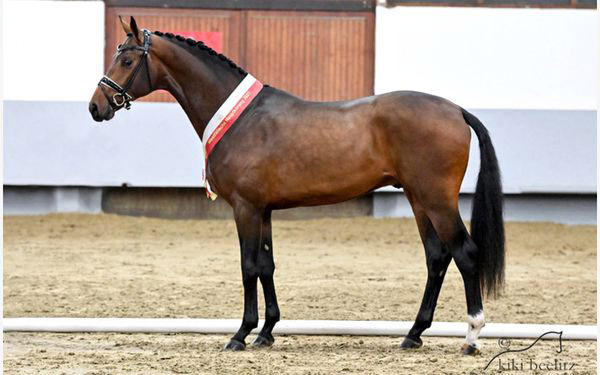
Escanero
More great new stallions for 2024 for Australian breeders –
“Escaneno (Escamillo x Rhodiamant), Global Hope (Global Player x Fidertanz) and Take That (Totilas x Danciano) are new from Klosterhof Medingen.”
Find out more:www.ihb.com.au

